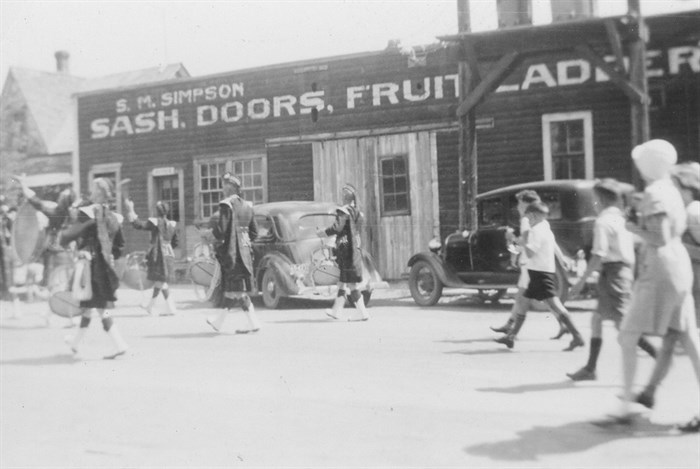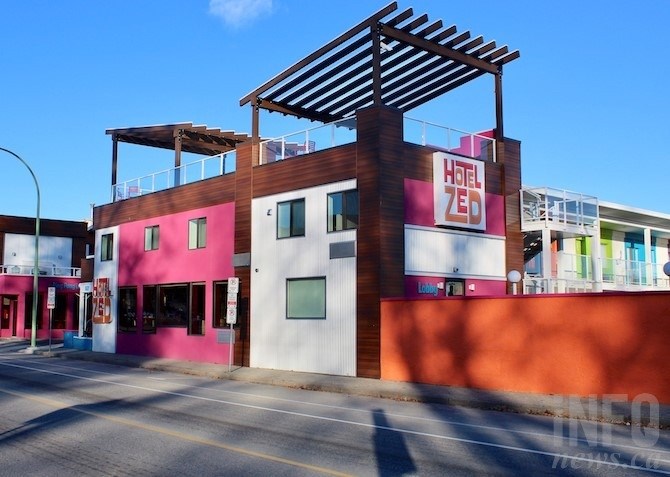
Parade participants march past S.M. Simpson Sash, Doors and Fruit Ladder on Abbott Street in 1917.
Image Credit: Kelowna Public Archives: KPA 10031
February 08, 2020 - 7:30 AM
Dig deep enough around Kelowna’s cultural district and south of Mill Creek and you may find a hidden link to the city’s past: Deep layers of sawdust left behind from old lumber mills and businesses.
Sharron Simpson’s grandfather Stanley Merriam Simpson made fruit boxes out of his business S.M. Simpson Sash, Door and Fruit Ladder in the 1920s, formerly located on Abbott Street at Hotel Zed’s current location. Simpson is a former city councillor, Okanagan Historical Society member and author of The Kelowna Story, which follows the city’s history from the first arrival of settlers to modern-day times.
“He made window frames and doors and expanded into making fruit boxes. In early Kelowna, there were millions and millions of fruit boxes because that’s how all the fruit was shipped out of the area and they had to have new wooden boxes every year,” Simpson said.
Cutting boxes with saws in the 1920s and 1930s created a large amount of sawdust. The work also created slabs, Simpson said.
With her grandfather’s business “there was such an enormous amount of waste, it filled all the spaces in the plant and (filled the entire laneway behind it with sawdust and slabs.) He was running out of space.”

A former fruit box business at the current Hotel Zed's location created sawdust and waste that got rid of Kelowna's marshy land.
Image Credit: Rob Munro
Stanley owned property south of Mill Creek, stretching from Abbott Street to Cadder Avenue, that included lakefront land. He would dump the unused boxes and sawdust into what was then swampy marshland. Over time, it accumulated and absorbed the water, she said.
“There were times that you could paddle a canoe all the way to the hospital,” she said. “It wasn’t prime real estate as it is today, so he took a lot of sawdust, slabs and bits of logs and soaked up all the water... It was swampy, filled with mosquitos and the lake flooded every year.”
Cadder Avenue residents have dug up logs and slabs and wondered how they got there, she said.
Kelowna also has a long history of flooding.
“Water Street is called Water Street for a reason, the lake would flood up to the street in early Kelowna,” Simpson said. “Most of the city is built on a flood plain.”
Mission Creek used to flood its banks in the 1930s and 1940s as well, she said.
According to Okanagan Heritage Museum executive director Linda Digby, the underground sawdust and logs serve as a reminder of how Kelowna was literally built upon the forest industry.
The sawmill where Kelowna’s last mill, Tolko, currently stands was started by Stanley in 1931.
“(The sawdust's) presence for this long speaks to how deeply this (city’s) history was linked to lumber. It’s hard to remember what a woodsy and rural and geographically isolated town we were,” she said.
Much of Kelowna’s cultural district is built on sawdust, she said, which was dumped from old lumber mills.
“Our identity is changing so fast it makes our head spin, but not that long ago it was part of our economy,” Digby said.
To contact a reporter for this story, email Carli Berry or call 250-864-7494 or email the editor. You can also submit photos, videos or news tips to the newsroom and be entered to win a monthly prize draw.
We welcome your comments and opinions on our stories but play nice. We won't censor or delete comments unless they contain off-topic statements or links, unnecessary vulgarity, false facts, spam or obviously fake profiles. If you have any concerns about what you see in comments, email the editor in the link above.
News from © iNFOnews, 2020